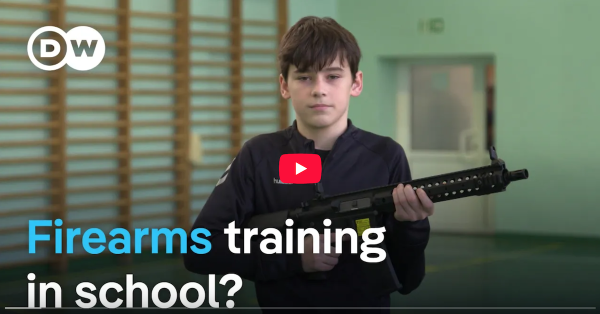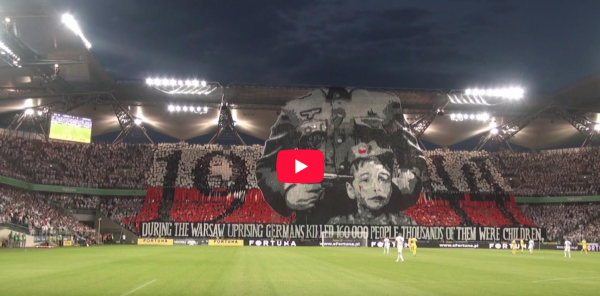
In the last couple days a story has popped up across social media that has caught the attention of many in the firearms community. The story is from DW News, which is Germany’s international broadcaster that produces content in 30 languages, including English.
During the early days of the Russian invasion of Ukraine, I watched several international news broadcasts – all in English – that were available on YouTube. This included news segments from DW.
U.S. media coverage of the invasion of Ukraine was rather uniform and often devoid of any historical context. This was particularly true as outlets like CNN covered Poland’s massive intake of Ukrainian refugees. They gushed effusively over how Poles didn’t hesitate to welcome these refugees into their country, often into their own homes.
In none of these heartwarming stories that I saw did any of the ‘talent’ even once mention the key motivation of the Poles. When it comes to being invaded by Russians, Poles have been there before.
Over 100 years ago in August of 1920, during the Polish–Soviet War, the Battle of Warsaw saw Polish military forces lead by Józef Piłsudski stop the Red Army at the banks of the Vistula River on the eastern side of Warsaw in what is now remembered at the Miracle on the Vistula.
Poland stopped the Red Army from spreading Bolshevism throughout Western Europe. That’s kind of their thing, though. Back on September 12 of 1683, Poland’s famed Winged Hussars, under King John III Sobieski of Poland, lead the largest mounted calvary charge in history to end the two-month siege of Vienna, and in doing so stopped the Ottoman Empire’s expansion into Europe.
And, of course, the Soviets returned to Poland on September 17 of 1939, after Nazi Germany invaded from the west on September 1st. The two countries had secretly agreed to divvy up Europe after signing the Molotov-Ribbentrop Pact which was publicly a non-aggression pact between the two.
Fearing the increased militarization of Germany under the Nazis, Poland made its own plans for security. In March of 1939 Great Britain and France pledged to assure Poland’s independence, and formally entered into the Anglo-Polish Mutual Assistance Treaty with Great Britain and France on August 25, 1939.
While Poland was preparing for war, Great Britain and France were not ready for war. Poland was essentially left to its own defense, Germany was not attacked from the west, and World War II began unabated.
That brings us to today and the story that has the gun world abuzz: ‘Poland makes firearms training mandatory for schoolchildren'.
Initial response to the story of mandatory firearms training in Polish schools has been met with a “we need this here in America” or “why can’t we do that here?” sort of take. Truth is, while it would be great to have some level of mandatory firearms education in schools, we’re not really concerned about invasion here in the United States. Beside being protected by two major oceans, Canada to our north, Mexico to our south, and the best military forces in the world, there’s that famous warning from Japan’s Admiral Isoroku Yamamoto, ”You cannot invade the mainland United States. There would be a rifle behind every blade of grass.”
Apparently Yamamoto did not actually say this, but it’s pretty much a true statement, which is why invading the United States is not much of an option. Besides, we all watched Red Dawn and know that’s the game plan should an invasion occur.
For Poland, invasion is always an option. While the rest of Europe sees their business dealings with Russia as a deterrent to conflict because it wouldn’t be in Russia’s best interest, Poland is under no such illusion.
Poland had been increasing its defense spending beyond the NATO required 2% of each member country's Gross Domestic Product (GDP) and topped NATO members in 2024 by spending 4.12%.
This month Poland is taking delivery of the first of the 32 F-35A fighters they purchased for $4.6B to bolster their air defenses. The Polish F-35As are designated Husarz. Yeah, after the legendary Polish Winged Hussars cavalry units from the 16th century.
The mandatory training of Polish school children in firearms handling isn’t about a Second Amendment-style right in Poland. It is literally based on the country’s historic battle for independence, freedom and self preservation.
Even though we’re coming up on the 80th anniversary of the end of World War 2, the impact on Poland has never really faded. In 2017 fans of Legia Warsaw FC unfurled a giant image of a German soldier holding a pistol to the head of a Polish child. Under it a banner in English read, “During the Warsaw Uprising Germans killed 160,000 people. Thousands of them were children.”

They would be fined by UEFA, the governing body of European football (soccer), for this demonstration, the timing of which was specifically August 2. The Warsaw Upraising began at 5:00pm on August 1, 1944. The best video of this fan demonstration can be found here on YouTube.
One of several stories about Nazi German atrocities during their control of Poland was of a group of kids rounded up by the Germans. The younger kids were playing, unaware of what was about to happen. As the children were lined up the youngest began to cry as they realized their fate. The older ones began to sing, “Jeszcze Polska nie zginęła,” the opening line of the Polish National Anthem. In English it is “Poland Is Not Yet Lost.” The children were all shot before they could finish.
Should Russia, or any of its client states, care to test Poland’s resolve it will find a Poland armed with modern weapons of war and not equipment a generation to two behind that of its enemy as they did in 1939.
They will also find a citizenry that has not forgotten its past, or the role Poland’s Armia Krajowa – the Home Army – played in fighting the Nazis. They were the real life ‘Wolverines’ decades before Patrick Swayze, Charlie Sheen, C. Thomas Howell made teenagers fighting foreign invaders a thing in 1984.
– Paul Erhardt, Managing Editor, the Outdoor Wire Digital Network